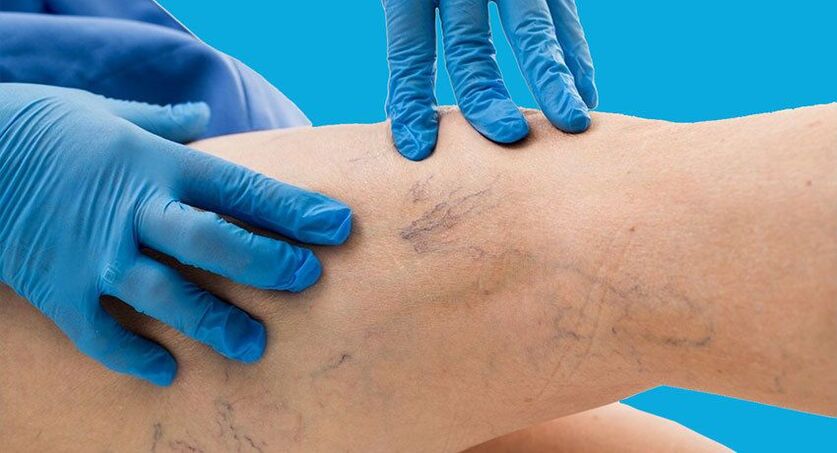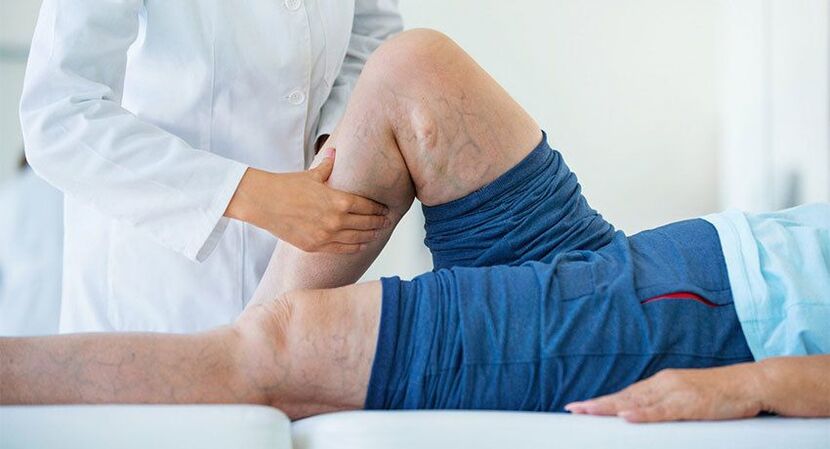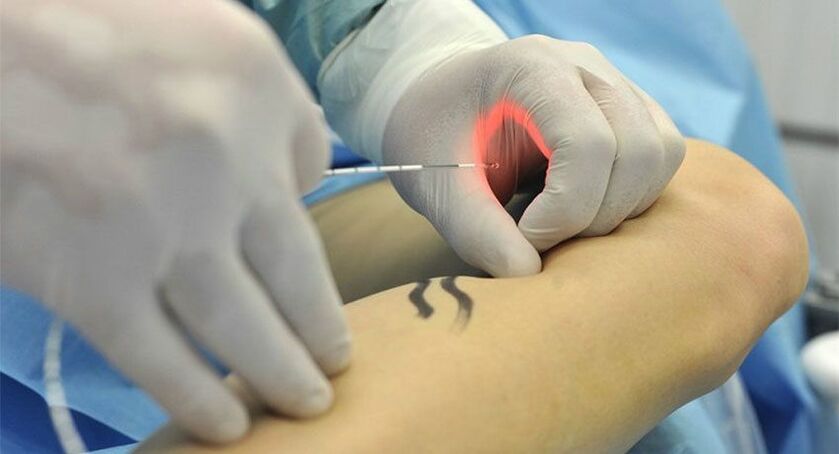Impaired blood flow and blood stagnation in the venous bed leads to pathological changes in blood vessels - varicose veins. The causes of the disease may vary and include genetic predisposition (most common), overweight, hormonal imbalance, pregnancy, arterial hypertension, constipation, lifestyle and occupational activities (e. g. , jobs requiring standing for long periods of time).In all these cases, the development of the disease follows the same scenario and is related to two factors: weak vessel walls and insufficiency of the venous valves.Blood vessel valves prevent blood from flowing back. If they fail to do their job, blood stagnates and pools (sediments) in the veins. As a result, the blood vessels not only dilate, but also become elongated, tortuous, and intertwined into varicose veins.
Most commonly, the disease affects the superficial veins (large and small veins) of the lower limbs. They ensure the outflow of venous blood from the subcutaneous tissue and skin, which together constitute no more than 1/10 of the entire circulatory system. The main work is done by the deep veins, which are connected to the superficial veins through perforating venous channels.Modern clinics use all modern methods for the treatment of varicose veins, including minimally invasive methods (intraluminal laser coagulation, sclerotherapy, phlebectomy) and classic phlebectomy with complete removal of the affected vein and its tributaries.Treatment of varicose veins always means excision or resorption of the veins, i. e. their exclusion from the general venous circulation system. But since such vessels play a minor role, eliminating them would not have any negative consequences. Their function is easily replaced by the remaining veins.
Symptoms and stages of disease
Varicose veins are one of the most common vascular diseases. According to statistics, 10-20% of men and 30-40% of women suffer from this disease.The first sign of pathology is the appearance of a pattern of blue or red blood vessels on the skin. This may be a network of capillaries or an asterisk (telangiectasia). They most commonly appear on the legs and thighs, but may also appear on the face, labia (in women), feet, and hands. Spider veins on the face are called rosacea.Symptoms of varicose veins depend on the stage of the disease. At first it's just a feeling of heaviness, increased leg fatigue, and moderate swelling at night that goes away with rest and sleep. Nighttime leg cramps are possible.The characteristic symptom of the disease is pain. Leg pain may appear or worsen when walking or standing for long periods of time, or may persist and be accompanied by feelings of fullness, burning, and warmth. Pain occurs when the enlarged veins are compressed.
In International Phlebology, the disease is classified from grades 0 to 6.In stage zero, there are no obvious symptoms; the only complaint may be heaviness in the legs.In the first stage, a blood vessel pattern (telangiectasia) appears, and muscle spasms occur at night. Type 2 disease manifests as dilation and thickening of subcutaneous veins.In the third stage, swelling in the legs (ankles, legs, feet) no longer goes away after a night of sleep, long periods of rest, and becomes persistent.In stage four, the skin over the dilated veins turns red or blue, areas of hyperpigmentation develop, and the skin becomes itchy, dry, peeling, and inflamed.Furthermore, in stages 5 and 6, preulcerative and trophic skin ulcers ensue.Therefore, varicose veins may start out as a cosmetic problem but can lead to serious health problems over time.complication
Stagnation of venous blood and its accumulation (deposits) in the blood vessels of the lower extremities can lead to a drop in blood pressure, hypotension, and associated dizziness, fainting, and headaches.The skin over the affected blood vessels becomes thinning, inflamed, peeling, itchy, congestive dermatitis and varicose eczema, followed by the formation of trophic ulcers.Blood clots develop in blood vessels that fill with stagnant venous blood. These clots can rupture at any time and travel throughout the body's circulatory system, blocking important arteries and causing death.
In the later stages of varicose veins, complications such as phlebitis and thrombophlebitis may occur.The later the treatment of the disease is started, the higher the risk of its complications, and more radical methods must be used to prevent them. Therefore, when symptoms of varicose veins appear, do not self-medicate, which is beneficial to prevention. But only a doctor can provide real help. Clinically, treatment of varicose veins is performed by qualified phlebologists and vascular surgeons who have extensive experience in conservative, minimally invasive and surgical treatment of the disease. It will determine the best treatment options based on the stage and characteristics of your varicose veins in your specific case.
Clinically, treatment of varicose veins is performed by qualified phlebologists and vascular surgeons who have extensive experience in conservative, minimally invasive and surgical treatment of the disease. It will determine the best treatment options based on the stage and characteristics of your varicose veins in your specific case.Diagnosis and treatment
As always, a visit to the doctor begins with a complaint investigation, medical record collection, and an external examination. The main methods for diagnosing varicose veins are Doppler ultrasound, duplex or triple ultrasound vascular scans.Typically, this approach provides a comprehensive overview of the disease to determine the most appropriate treatment strategy.If more data is needed to confirm the diagnosis, your doctor may order an X-ray (radiography venography), an MRI of the blood vessels (magnetic resonance venography), or a multi-spiral computerized angiogram.Before minimally invasive and extensive surgical intervention, a standard set of tests is performed - general urine test, general clinical and biochemical blood test, coagulation function test (coagulation map), HIV, syphilis, viral hepatitis test, fluoroscopy, Electrocardiogram. In most cases, varicose vein treatment in modern clinics is performed on an outpatient or day hospital basis. It does not require a break from your daily routine and you can resume your normal activities after just 1-2 hours. Minimally invasive surgery is performed with local anesthesia or without the use of any anesthesia.Only radical surgical intervention (phlebectomy) may require a short hospitalization in the clinic's inpatient unit.medical treatement
In the early stages of disease development or for prevention, doctors may prescribe medications, including antibiotics and antiseptics (when inflammation is present), venous protectors, anticoagulants (to prevent thrombosis), venous protectors, heparin ointment andOther heparins contain medications.Leech therapy can be used as an alternative treatment.Conservative treatment includes wearing compression stockings (tights, knee socks) and elastic bandages. Its scope is limited.Endovenous Laser Vascular Coagulation (EVLC)
This method refers to a minimally invasive method of treating varicose veins. The surgery is performed on an outpatient basis under local anesthesia. Under ultrasound control, a flexible fiber optic light guide connected to a transmitting device is inserted into the vascular bed.Laser light of a certain wavelength is absorbed by blood cells and vein walls and converted into heat.As a result, the blood vessels become sealed and turn into thin bundles of connective tissue that dissolve on their own.Laser coagulation is often used to treat small to medium-sized varicose veins, especially those on the face. But with its help you can also eliminate large varicose veins, including the small and great saphenous veins in the legs.
radiofrequency ablation
This method, like EVLC, is based on thermal coagulation, using only radiofrequency radiation instead of lasers to seal the containers. Otherwise, the process is similar. Under local anesthesia, a radio wave transmitter is introduced into the venous bed, where it is absorbed by the blood and vessel walls, converted into heat and produces coagulation. The procedure is performed under ultrasound guidance.Like laser coagulation, radiofrequency ablation can be used as a primary, sole, and adequate modality or as an add-on modality as part of a complex treatment. For example, after surgical removal of the main trunk to eliminate smaller vascular tributaries.Sclerotherapy
In this case, the varicose veins are hardened - glued together from the inside with the help of a sclerosing agent. This medication is given by injection into a vein. It can be in liquid or foam form.The procedure is completely painless; there may be a slight burning and stinging sensation during the procedure. To eliminate these sensations and further compress the blood vessels, a stream of cold air can be used. This is called cryosclerosis.There are many advantages to using a foam hardener. They provide better contact with the vessel wall, thereby increasing the efficiency of the procedure. To achieve this result, significantly smaller amounts of sclerosing agent are required, as it does not dissolve in the blood.
Additionally, it does not spread beyond the procedure area, making its volume more manageable.Liquid sclerosants are often used to eliminate small varicose veins, while foam preparations can even harden large veins.Sclerosis of small veins and capillaries is usually performed under visual control, whereas introduction of foam sclerotherapy into large vessels is performed under ultrasound control.
venous resection
This is a minimally invasive surgical method to remove varicose veins. It does not require any incisions, anesthesia, or epidurals.Treatment for this surgery takes place in a day hospital. The doctor performs an ultrasound scan of the blood vessels and marks them on the skin with a marker. Afterwards, he performs a puncture (an incision no larger than 1-2 mm) and pulls out part of the vein using a special hook. The area is pinched and cut off.Next, the doctor moves to the next area, performs a puncture, pulls out a section of the vein and cuts it off. This allows him to remove the entire affected blood vessel.Skin puncture wounds heal quickly without leaving traces, thereby achieving ideal cosmetic results. Since there are no incisions, the recovery period is short. Cut blood vessels don’t require stitches, and punctures don’t require stitches—just seal them with adhesive tape.phlebectomy
This is a classic surgical procedure that has been used less and less recently. It involves complete removal of the varicose vein along its entire length. To do this, an incision is made in the groin or under the knee and a probe is inserted into the blood vessel.With the help of a probe, the blood vessel is separated from the surrounding tissue and pulled out. The surgery is performed under general anesthesia or epidural anesthesia.recovery
After varicose vein treatment, you will need to wear compression stockings. For the first few days it should be worn around the clock, and over the next few weeks it should be worn only during the day and can be removed at night. General restrictions during recovery include no hot baths, steam baths and saunas.After minimally invasive surgery (laser coagulation, radiofrequency ablation, sclerotherapy, venous resection), it is recommended to get up and walk around. In the future, it is recommended that walking be a compulsory part of the rehabilitation course (at least 1 hour per day), while other physical activities should be limited.The duration of the recovery period depends on the amount of treatment and surgical intervention.Thanks to the use of highly qualified medical professionals and modern technology, treatment of varicose veins is usually well tolerated by patients, causes no complications and provides maximum results.





















